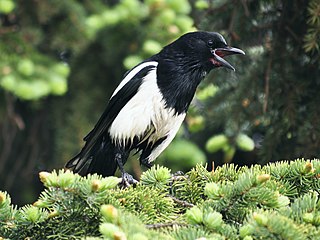
The black-billed magpie, also known as the American magpie, is a bird in the corvid family found in the western half of North America. It is black and white, with black areas on the wings and tail showing iridescent hints of blue or blue-green. It is one of only four North American songbirds whose tail makes up half or more of the total body length.

The mountain weasel, also known as the pale weasel, Altai weasel or solongoi, primarily lives in high-altitude environments, as well as rocky tundra and grassy woodlands. This weasel rests in rock crevices, tree trunks, and abandoned burrows of other animals or the animals it previously hunted. The home range size of this animal is currently unknown. Geographical distribution for this species lies in parts of Asia from Kazakhstan, Tibet, and the Himalayas to Mongolia, northeastern China, and southern Siberia. The most common area for this species, however, is Ladakh, India. The conservation status, according to the IUCN, is near threatened because it is considered to be in significant decline and requires monitoring mainly because of habitat and resource loss.

Daphnis nerii, the oleander hawk-moth or army green moth, is a moth of the family Sphingidae. It was described by Carl Linnaeus in his 1758 10th edition of Systema Naturae.

The long-eared chipmunk, also called the Sacramento chipmunk or the four-banded chipmunk, is a species of rodent in the squirrel family, Sciuridae. It is endemic to the central and northern Sierra Nevada of California and Nevada in the United States. Long-eared chipmunks have the longest ears of all species of chipmunks.

Fabulina fabula, the bean-like tellin, is a species of marine bivalve mollusc in the family Tellinidae. It is found off the coasts of northwest Europe, where it lives buried in sandy sediments.
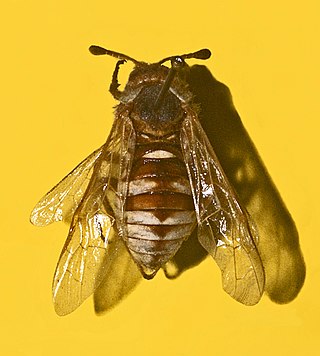
Cimbex quadrimaculatus is a species of sawflies in the family Cimbicidae.

Crossocerus is a genus of square-headed wasps in the family Crabronidae. There are at least 250 described species in Crossocerus.
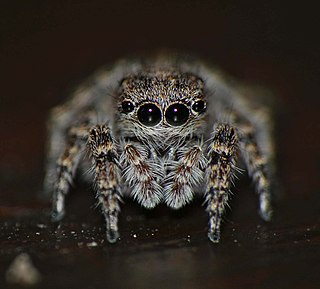
Langelurillus quadrimaculatus is a species of jumping spider in the genus Langelurillus that lives in Nigeria. It was first described in 2011 by Wanda Wesołowska and Anthony Russell-Smith. The spider is small, with a cephalothorax that is between 1.7 and 2.5 mm long and an abdomen between 2.0 and 2.2 mm long. The female is larger than the male. It can be distinguished from other species in the genus by its abdominal pattern, which is recalled in the species name, that consists of two pairs of rounded yellow patches on a brownish-grey background. The female also has a distinctive internal layout of its seminal ducts within its short and wide epigyne.
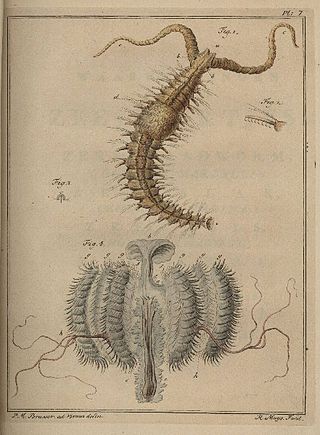
Polydora ciliata is a species of annelid worm in the family Spionidae, commonly known as a bristleworm. It is a burrowing worm and is found in the northeastern Atlantic Ocean and some other parts of the world.

Elateroides dermestoides is a species of ship-timber beetles native to Europe.
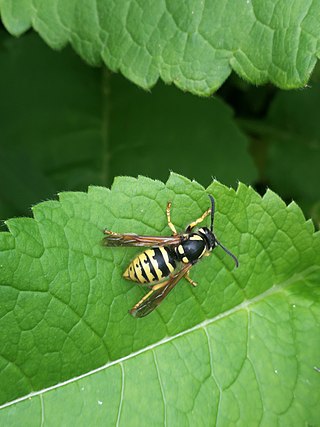
Dolichovespula omissa is a species of wasp in the family of Vespidae. It lives as a social parasite by letting colonies of Dolichovespula sylvestris raise their young.

Larinia jeskovi is a species of the family of orb weaver spiders and a part of the genus Larinia. It is distributed throughout the Americas, Africa, Australia, Europe, and Asia and commonly found in wet climes such as marshes, bogs, and rainforests. Larinia jeskovi have yellow bodies with stripes and range from 5.13 to 8.70 millimeters in body length. They build their webs on plants with a small height above small bodies of waters or wetlands. After sunset and before sunrise are the typical times they hunt and build their web. Males usually occupy a female's web instead of making their own. The mating behavior is noteworthy as male spiders often mutilate external female genitalia to reduce sperm competition while female spiders resort to sexual cannibalism to counter such mechanisms. The males also follow an elaborate courtship ritual to attract the female. The bite of Larinia jeskovi is not known to be of harm to humans.
Sphegina abbreviata is a species of hoverfly in the family Syrphidae found in Nepal. Like other species in its genus, S. abbreviata is small, slender, and usually found in and around woodlands. It's similar to S. angustata, though it's differentiated by having both dorsal and ventral sublobes posteriorly on male superior lobe instead of just a dorsal one, and by having the dorsal sublobes be apically short and truncate instead of long and pointed.
Sphegina angustata is a species of hoverfly in the family Syrphidae found in Nepal. It's similar to S. abbreviata, though it's differentiated by having only a dorsal sublobe posteriorly on the male superior lobe instead of both dorsal and ventral, and by having the dorsal sublobe be long and pointed instead of apically short and truncate.
Sphegina (Asiosphegina) brevipilus is a species of hoverfly in the family Syrphidae found in China. It's similar to both S. (A.) plautus and S. (A.) simplex; it and S. (A.) plautus are the only known species with a sclerite between the bases of surstyli as well as posteriorly from the cerci.
Sphegina (Asiosphegina) bilobata is a species of hoverfly in the family Syrphidae found in Myanmar. It's set apart from other species by its general pale yellowish color with three black longitudinal stripes on the scutum combined with the infuscated pattern at cross veins on the wing. The male sternite IV with its symmetrical pair of short spinose lobes posteriorly is quite distinct.
Sphegina (Asiosphegina) carinata is a species of hoverfly in the family Syrphidae found in Kambaiti Pass, Myanmar, a montane forest with swampy areas and streams located 2000 meters above sea level.
Sphegina crassispina is a species of hoverfly in the family Syrphidae found in Kambaiti Pass, Myanmar, a montane forest with swampy areas and streams located 2000 meters above sea level. A specimen was found in China that fits the description of S. crassispina save for the more extensively shiny frons and the slightly more protruding frontal prominence.
Sphegina apicalis is a species of hoverfly in the family Syrphidae found in Taiwan.
Sphegina guptai is a species of hoverfly in the family Syrphidae found in India. It's similar to S. elegans in general appearance and characters of the male genitalia. It differs from known Oriental species of Sphegina by the shiny black abdomen with widened terga III and IV. Only S. quadrisetae has a somewhat similar appearance.












